Gantry cranes are widely used for material handling in various industries to improve working efficiency and material handling safety. What’s an overhead gantry crane and how to select the right overhead gantry crane for your application? All the basics of overhead gantry cranes you need to know will be presented for you, which mainly include the following contents:
Dejun Crane is aimed to help you understand what type of overhead gantry crane will be most beneficial for your application.
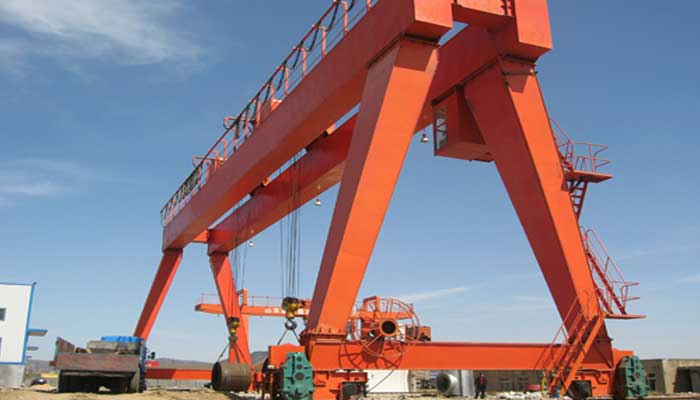
Types of gantry cranes part 1 – Double girder gantry crane
What is An overhead gantry crane?
An overhead gantry crane is a type of overhead crane with a single or double girder configuration supported by freestanding legs that move on wheels or along a track or rail system. Overhead gantry cranes are usually considered when there is a reason not to incorporate an overhead runway system.
These are typically used for an outdoor application or below an existing overhead bridge crane system. Unlike an overhead crane, an overhead gantry crane does not need to be tied into a building’s support structure—eliminating the need for permanent runway beams and support columns. In some cases, this can result in a significant reduction in material costs and can be a more cost-effective solution compared to a similarly specified bridge crane.
Larger gantry systems may run on a rail or track embedded in the ground, typically in a straight line in a dedicated work area. Smaller portable gantry systems run on castors or wheels and can be moved about a facility for maintenance or light fabrication work.
An overhead gantry crane is different from an overhead crane in terms of the spectacular features that it posses.
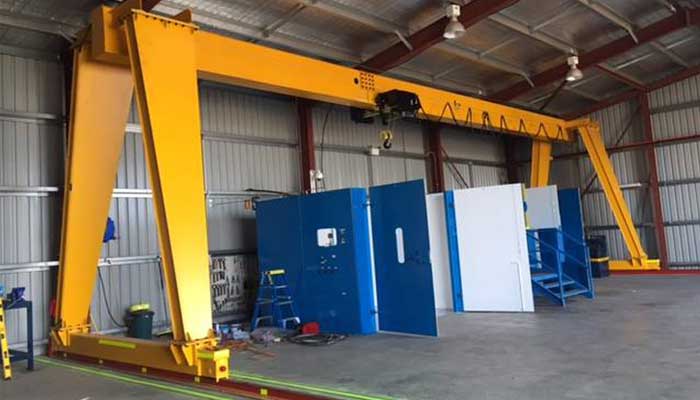
Types of gantry cranes part 2 – Single girder gantry crane
There are different types of overhead gantry cranes available, depending on the structure and the application. Let’s discuss the different kinds of overhead gantry cranes below.
No matter how the form of overhead gantry crane , its composition is mainly divided into three parts: mechanical parts, structural parts and electrical parts. Specifically, overhead gantry crane mainly composed the gantry frame structure, trolley, running mechanism, electrical device, cabin, and other parts.
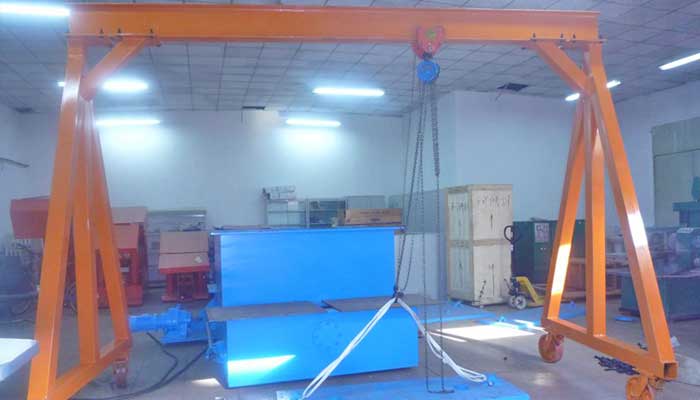
Types of gantry cranes part 3 – Portable gantry crane
Gantry frame structure
The gantry frame structure is mainly composed of the main beam and the supporting legs. The main beam is used for supporting the loading trolley, and the supporting leg is running along the track through the supporting leg. The light overhead gantry crane uses the single beam, the heavy overhead gantry crane , uses the double beam. As for the supporting legs of heavy crane, one side of the supporting legs generally use rigid legs, the other side uses a flexible leg, in order to reduce the deadweight and compensate the deviation of span.
Trolley
Trolley of the double girder overhead gantry crane is basically the same as that of bridge crane. Single main beam adopts electric hoist as a trolley, but is not a common electric hoist.
Running bridge structure
The trolley running mechanism is the same as the bridge crane, use respectively driven. As overhead gantry crane generally operates in open air, the lower part of the supporting leg is provided with a rail clamping device or a rail gauge. When the crane does not work or in a strong wind, with the clamping to Clamp rail, in order to prevent the crane accident by the wind.
Motor
The running state of the motor is divided into two kinds, which are electric state and power generation state. In overhead gantry crane , when the electric motor is introduced, the motor starts to run, and the electric energy can be changed into mechanical energy, this operation state is referred to as the electric state. When mechanical energy is added to the motor shaft, in addition to the loss of the motor itself, the motor can be converted into electrical energy, this state of operation is called the state of power generation. Under certain conditions, any motor can be operated by any state in the above two states.
Cabin
Cabin is the site where operators control the overhead gantry crane , as the overhead gantry crane is an important hoisting equipment for loading and unloading large goods, the operation of the crane has a direct impact on the production efficiency.
Gantry cranes have a wide range of applications owing to their high efficiency and performance. They can work well both under indoor and outdoor settings.
They are used in indoor places like warehouses, workshops, garages, maintenance, and manufacturing units.
In outdoor settings, they can be used in the port, yard, freight, shipyard, dock, etc. some of the uses of overhead gantry cranes in industry include-
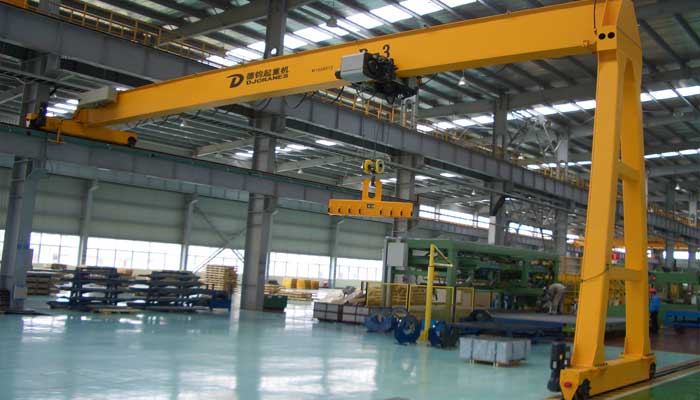
Types of gantry cranes part 4 – Semi -gantry crane which can be designed with 1 or two legs
Gantry cranes are a popular alternative to the overhead bridge crane. Investing in any crane kind can improve your efficiency, operations, productivity, and increase worker’s safety. Selecting the right overhead gantry crane is critical to ensuring your work efficiency and safety. In the selection of An overhead gantry crane , you need to consider a few things so as to identify the right one for your application.
The selection of single or double girder is determine by the rated lifting capacity, working speed and size of load. In general, the single girder overhead gantry crane can be used when the lifting capacity is below 30 tons and the span is within 35m. If the width of the gantry legs is required to be large, the working speed is high, or heavy and long pieces are often hoisted, a double girder overhead gantry craneshould be selected.
The span of An overhead gantry crane is an important factor affecting the weight of the crane itself. The span length should be minimized on the premise of meeting the conditions of equipment use and meeting the standard of span series.
It should meet the stability requirements of the gantry in the direction of the crane track.
The overall dimensions of the cargo must be able to pass through the flat steel frame of the leg smoothly.
The wheelbase (B) is proportional to the span (S). Generally, the wheelbase B = (1 / 4-1 / 6) S.
During operation, there should be a certain space size between the external dimensions of the overhead gantry crane , the cargo in the yard and the transportation vehicle passages to facilitate loading and unloading operations. When loading and unloading within the span, the transport vehicle shall maintain a distance of more than 0.7m from the support legs. When not working, the spreader should have a distance of more than 0.5m from the transport vehicle, and the cargo should have a distance of more than 0.5m when it passes through the support legs.
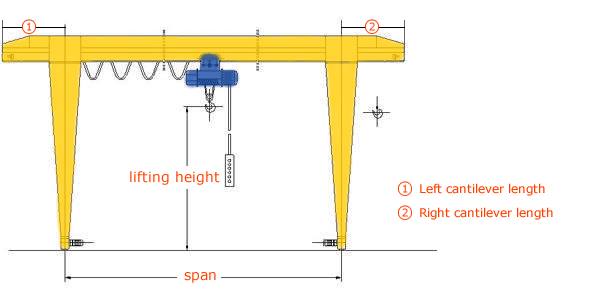
Please provide some basic information about the crane you need so we can provide you with the right quote.
Gantry cranes are designed to handle heavy-weight objects and provide an efficient means of lifting or moving loads and materials. Moving or lifting heavy equipment need not be expensive or permanently changing. Through overhead gantry cranes, they can be easily relocated. They can be assembled and disassembled easily and quickly, making them ideal for use in multiple work areas or rented facilities.
With over 34 years of overhead crane manufacturing and engineering, we are able to provide you various different types of cranes services from design, manufacturing to installation. If you have any need or doubt, please feel free to contact us.